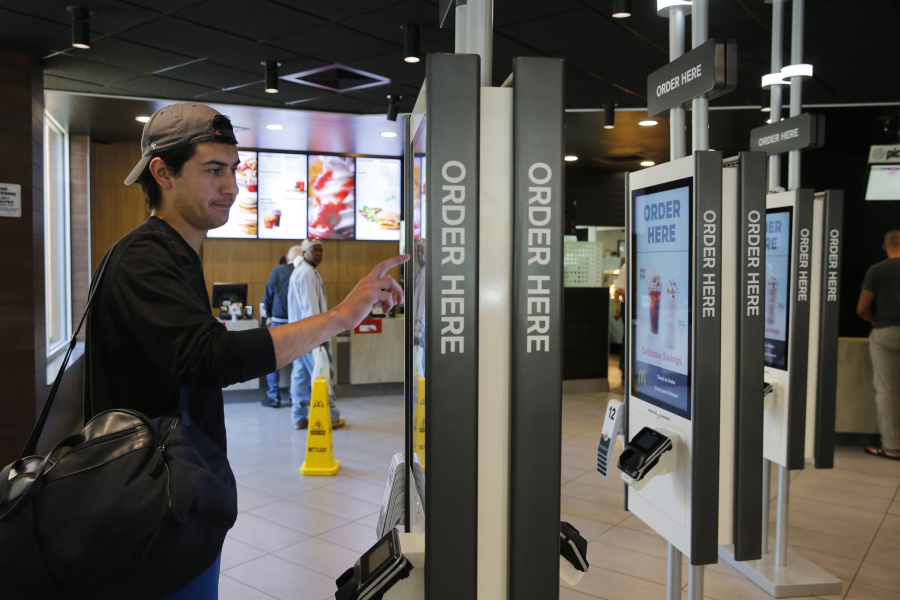U.S. restaurants have been on a hiring binge in recent years, far outpacing the rest of the economy. But their appetite for more employees looks to be waning.
McDonald’s and Subway, two of the largest fast-food chains in North America, have cut back on new-store openings and closed some locations. Supermarkets including Kroger are pushing prepared foods, while meal kits are making it cheaper and easier for people to eat at home. Wendy’s and McDonald’s plan to install hundreds of digital ordering kiosks by year-end to boost sales as labor costs rise.
While eating out remains popular, restaurants face headwinds from competition, overbuilding and automation, especially at fast-food chains. The threats loom over an industry that’s punched above its weight in America’s labor market: Since the start of the expansion in mid-2009, it has added 2.3 million jobs, or 15 percent of the private-sector increase, while employing only 9 percent of private workers.
Now, that growth is looking more sedate. Hiring at restaurants and bars in 2016 was the weakest since 2010, and is running similar to that so far this year. A deeper slowdown would crimp nationwide payroll gains that have mostly beaten forecasts this year, with hurricane-impacted September data due Friday.
“The best times for restaurant employment have passed,” said Ryan Sweet, a Moody’s Analytics economist. While he anticipates demand may underpin a “fairly solid” pace of hiring the next few years, “it’s unlikely restaurants will be able to duplicate the kind of job gains we’ve seen since the expansion began.”
Thousands of restaurants, coffee shops and bars opened across the country as consumers recovering from the recession began spending more freely on eating out. In 2015, for the first time, Americans spent more at restaurants than at traditional grocery stores.
Industry watchers say the landscape is changing rapidly. Quick-service chains that drove growth in new locations look especially vulnerable. NPD Group forecasts customer visits to fast-food restaurants will be little changed this year and next, with sales growth being driven mainly by menu-price hikes rather than higher traffic.
There’s a growing sense the industry is saturated. McDonald’s, Burger King and Wendy’s are increasingly battling for market share. Compared with the spring of 2016, chain restaurants slowed openings this year while independent eateries with one or two units saw an outright decline in locations, NPD data show. Analysts are questioning whether Starbucks Corp. overbuilt, while rival Dunkin’ Donuts recently reduced its new-store target.
It’s all part of the toughest competition ever in the $1.5 trillion market for “stomach share” — an industry term for everything that Americans eat — and Amazon.com recently joined the fray. A streak of food deflation unseen in 60 years has made grocery shopping cheaper, supermarkets are offering more ready-to-eat food, and Blue Apron Holdings and others are doing meal-kit deliveries.
That’s added to the pressure facing chain restaurants. “The pie is not really growing — it’s a matter of how much of that pie you can get,” said Michael Harms, executive director of operations at Dallas-based industry researcher TDn2K.
Then there are labor costs. Restaurant wages have grown about 4 percent since mid-2016, twice the pace of private earnings, amid a tight job market and minimum-wage hikes in some states. While good for industry employees, pay gains may be behind some of the deceleration in hiring and thus “somewhat of a double-edged sword,” said Sweet, of Moody’s in West Chester, Pa.
Fast-food chains are also diving headfirst into automation, including touch-screen devices that tend to lead to bigger orders. McDonald’s plans to have digital ordering stations at about 2,500 restaurants by the end of 2017. By then, Wendy’s plans to have digital kiosks at about 300 locations.
Shake Shack, the burger chain founded by restaurateur Danny Meyer, is opening its first location without cashiers this month in New York. At Panera Bread, about 25 percent of sales come through digital platforms, including its website, mobile app and kiosks. Even Domino’s Pizza is testing consumers’ appetite for driverless delivery with Ford.
While such innovations may eventually help restaurants function with fewer employees, the future hasn’t totally arrived yet. Job openings at restaurants and hotels climbed to a record in July, though that partly reflects high turnover, which makes it harder for chains to recruit in a tight labor market.
For now, automation is still expensive and while it may make sense at fast-food restaurants serving thousands of customers a day, workers who can take out the trash and clean the windows during their downtime are still a better option for many owners, according to John Gordon of Pacific Management Consulting Group in San Diego.
“I’m not sure all that versatility is factored in — a robot isn’t good at going from task to task,” he said.



